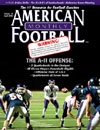AMERICAN FOOTBALL MONTHLY THE #1 RESOURCE FOR FOOTBALL COACHES
Article CategoriesAFM Magazine
|
Quarterback Development (off-season)© More from this issueMany kids want to be the quarterback when they begin playing the game of football. However, few realize how much time, effort, and pressure come with the position. In today’s game, it is essential to establish an off-season “training” program for an incoming or returning quarterback. There are three areas that we focus on during the off-season. They are: mental preparation, mechanics, and recognition. The mental preparation is one of the most important aspects of the off-season. This helps get their minds focused and ready for both football and their everyday life. The quarterbacks are first brought into the classroom to go over expectations and responsibilities that are associated with the position. We firmly believe that they must know their roles/responsibilities and what is expected of them in order for them to be as ....The full article can only be seen by subscribers. Subscribe today!
|
|
|||||||
| HOME |
MAGAZINE |
SUBSCRIBE | ONLINE COLUMNISTS | COACHING VIDEOS |
Copyright 2025, AmericanFootballMonthly.com
All Rights Reserved





